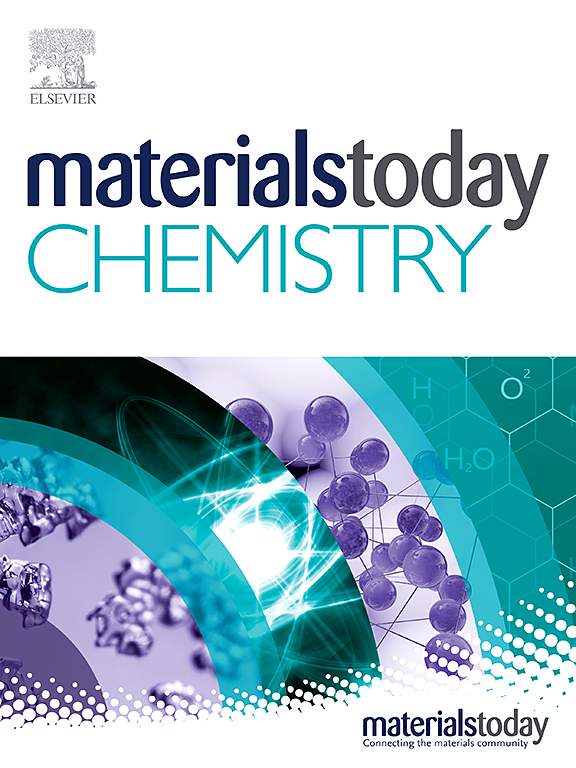Polyether-based composite solid-state electrolyte to realize stable high-rate cycling for high-voltage lithium metal batteries at room temperature
IF 6.7
2区 化学
Q1 CHEMISTRY, MULTIDISCIPLINARY
引用次数: 0
Abstract
Polyether electrolytes, which possess benefits in terms of lithium salt solubility, compatibility with lithium metal, and material availability, are promising candidate materials for solid-state lithium metal batteries with high safety and specific energy. However, achieving stable cycling at high rates under room temperature conditions for high-voltage lithium metal solid-state batteries is a significant challenge. In this study, a polyether-based composite solid-state electrolyte was fabricated via in situ polymerization, and a novel polyether matrix (PDSi) was synthesized by copolymerization of 1,3-dioxolane (DOL) and 3-(glycidoxypropyl)triethoxysilane (GPTES). The triethoxysilicon groups of PDSi improve the antioxidant capacity of polyether and interact with anionic groups, thereby enabling a wide electrochemical window of 5.5 V and a high lithium-ion transference number t of 0.56 at room temperature. In addition, a prepared PDSi@LLZTO electrolyte with an asymmetric structure mitigated the side reaction between the LLZTO ceramic filler and lithium. Here, PDSi@LLZTO exhibited a lithium-ion transference number of 0.67 and ionic conductivity of 1.28 × 10 S cm at 20 °C. More importantly, the Li|PDSi@LLZTO|NCM523 cell demonstrated excellent capacity retention of 83.9 % after 200 cycles at a high-rate discharge of 3C. The proposed material and structure design provide a unique perspective for the development of an effective polymer-based electrolyte for high-voltage lithium metal batteries.基于聚醚的复合固态电解质实现高压金属锂电池在室温下的稳定高倍率循环
聚醚电解质在锂盐溶解性、与锂金属的兼容性和材料可用性等方面具有优势,是具有高安全性和高比能量的固态锂金属电池的理想候选材料。然而,在室温条件下实现高电压锂金属固态电池的高速稳定循环是一项重大挑战。本研究通过原位聚合制造了一种聚醚基复合固态电解质,并通过 1,3-dioxolane (DOL) 和 3-(glycidoxypropyl)triethoxysilane (GPTES) 的共聚合成了一种新型聚醚基质 (PDSi)。PDSi 的三乙氧基硅基团提高了聚醚的抗氧化能力,并与阴离子基团相互作用,因此在室温下具有 5.5 V 的宽电化学窗口和 0.56 的高锂离子转移数 t。此外,制备的具有不对称结构的 PDSi@LLZTO 电解质可减轻 LLZTO 陶瓷填料与锂之间的副反应。在这里,PDSi@LLZTO 在 20 °C 时的锂离子转移数为 0.67,离子电导率为 1.28 × 10 S cm。更重要的是,在 3C 的高速放电条件下,锂离子电池经过 200 次循环后,容量保持率高达 83.9%。所提出的材料和结构设计为开发用于高压锂金属电池的有效聚合物基电解质提供了一个独特的视角。
本文章由计算机程序翻译,如有差异,请以英文原文为准。
求助全文
约1分钟内获得全文
求助全文
来源期刊

Materials Today Chemistry
Multiple-
CiteScore
8.90
自引率
6.80%
发文量
596
审稿时长
33 days
期刊介绍:
Materials Today Chemistry is a multi-disciplinary journal dedicated to all facets of materials chemistry.
This field represents one of the fastest-growing areas of science, involving the application of chemistry-based techniques to the study of materials. It encompasses materials synthesis and behavior, as well as the intricate relationships between material structure and properties at the atomic and molecular scale. Materials Today Chemistry serves as a high-impact platform for discussing research that propels the field forward through groundbreaking discoveries and innovative techniques.
 求助内容:
求助内容: 应助结果提醒方式:
应助结果提醒方式:


